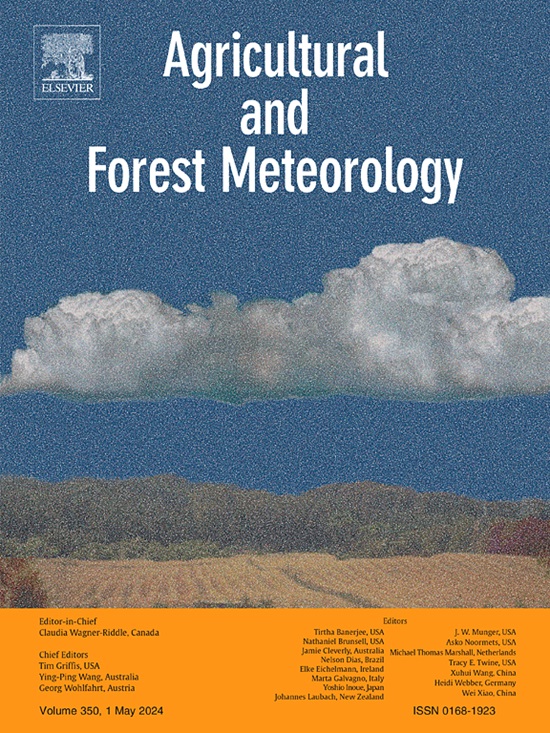Towards an enhanced metric for detecting vertical flow decoupling in eddy covariance flux observations
IF 5.6
1区 农林科学
Q1 AGRONOMY
引用次数: 0
Abstract
The eddy covariance (EC) technique has emerged as the method of choice for observing ecosystem–atmosphere interactions across biomes and climate zones. However, EC measurements are biased when the turbulent flow is decoupled from the underlying surface, severely limiting the applicability of the technique in observing surface–atmosphere fluxes. Friction velocity () is typically used to detect and filter these periods from EC flux time series. The processes that control decoupling are understood qualitatively, including the strength of vertical turbulent mixing, stable stratification and canopy drag. However, the standard practice utilising misses most of these processes, resulting in a significant uncertainty in detecting decoupling. Consequently, a quantitative metric, , which encapsulates all these processes in a unified framework, was recently proposed. However, it has not yet been systematically tested over a range of ecosystems and site characteristics. The objectives of this study were therefore to test the efficacy of at a diverse range of EC sites, to quantify the processes controlling decoupling across sites, and to compare against other decoupling metrics, such as . A similar threshold value for coupling was observed at all the 45 tested EC sites, with a value of 0.59 (median; 0.5...0.63 interquartile range). This indicates that the metric captured the essential features of decoupling across sites, thereby enabling deeper analyzes of the causes of decoupling. For example, indicates that (1) flows above dense forest canopies can be decoupled from the forest floor also during the daytime due to canopy drag and that (2) during stable stratification decoupling is more likely with tall towers. These findings significantly enhance our scientific understanding of the underlying causes of decoupling, will inform improved analyzes of EC data and support near-surface turbulence transport analyzes in open and forested landscapes.
涡流相关通量观测中检测垂直流解耦的增强度量
涡旋相关方差(EC)技术已成为观测跨生物群系和气候带生态系统-大气相互作用的首选方法。然而,当湍流与下垫面解耦时,EC测量结果存在偏差,严重限制了该技术在观测地表-大气通量方面的适用性。摩擦速度(u∗u∗)通常用于从EC通量时间序列中检测和过滤这些周期。控制解耦的过程被定性地理解,包括垂直湍流混合强度、稳定分层和冠层阻力。然而,使用u∗u∗的标准实践忽略了大多数这些过程,导致在检测解耦时产生重大的不确定性。因此,最近提出了一个定量度量,ΩΩ,它将所有这些过程封装在一个统一的框架中。然而,它尚未在一系列生态系统和场地特征上进行系统测试。因此,本研究的目的是测试ΩΩ在不同EC位点的功效,量化控制跨位点解耦的过程,并将ΩΩ与其他解耦指标(如u∗u∗)进行比较。在所有45个测试的EC位点观察到相似的ΩΩ耦合阈值,其值为0.66±0.06(平均值±标准差)。这表明ΩΩ指标捕获了跨站点解耦的基本特征,从而能够对解耦的原因进行更深入的分析。例如,ΩΩ表明(1)由于冠层阻力,白天浓密森林冠层上方的流动也可以与森林地面解耦,(2)在稳定分层期间,与高塔解耦的可能性更大。这些发现大大提高了我们对解耦的根本原因的科学理解,将为改进EC数据的分析提供信息,并支持在开阔和森林景观中进行近地表湍流输送分析。
本文章由计算机程序翻译,如有差异,请以英文原文为准。
求助全文
约1分钟内获得全文
求助全文
来源期刊
CiteScore
10.30
自引率
9.70%
发文量
415
审稿时长
69 days
期刊介绍:
Agricultural and Forest Meteorology is an international journal for the publication of original articles and reviews on the inter-relationship between meteorology, agriculture, forestry, and natural ecosystems. Emphasis is on basic and applied scientific research relevant to practical problems in the field of plant and soil sciences, ecology and biogeochemistry as affected by weather as well as climate variability and change. Theoretical models should be tested against experimental data. Articles must appeal to an international audience. Special issues devoted to single topics are also published.
Typical topics include canopy micrometeorology (e.g. canopy radiation transfer, turbulence near the ground, evapotranspiration, energy balance, fluxes of trace gases), micrometeorological instrumentation (e.g., sensors for trace gases, flux measurement instruments, radiation measurement techniques), aerobiology (e.g. the dispersion of pollen, spores, insects and pesticides), biometeorology (e.g. the effect of weather and climate on plant distribution, crop yield, water-use efficiency, and plant phenology), forest-fire/weather interactions, and feedbacks from vegetation to weather and the climate system.

 求助内容:
求助内容: 应助结果提醒方式:
应助结果提醒方式:


